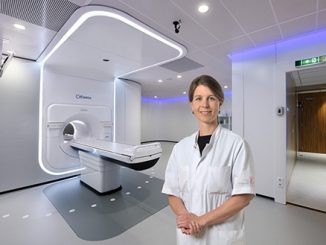MagnoTherm Wows the Sustainability Movement with Magnetocaloric Refrigerator
Very few companies have mastered the science of magnetocalorics sufficiently to develop a commercial refrigerator, but perhaps none have also been successful in making the concept “cool” from a marketing standpoint. Now, though, a young academic spinoff company from Darmstadt, Germany is changing the landscape with its Polaris beverage refrigerator.
First U.S.-Built Focusing Magnet for LHC Upgrade Arrives at CERN, Uses New Superconducting Material
After twenty years of research, development, testing and production, the United States is now shipping state-of-the-art superconducting accelerator magnets to CERN for the high-luminosity upgrade to the Large Hadron Collider in Switzerland. At the heart of these powerful magnets is a new superconducting material used for the first time in a particle accelerator.
A Blueprint for More Powerful Superconducting Magnets
Researchers from the Accelerator Technology & Applied Physics (ATAP) Division at Berkeley Lab, in collaboration with colleagues from the Lab’s Engineering Division and the Applied Superconductivity Center at the National High Magnetic Field Laboratory (NHMFL), have built a new superconducting magnet that shows potential for generating extremely high magnetic fields. It could enable more powerful, energy-efficient particle accelerators that are less expensive to build and operate than current technologies.
Tech Tips: Understanding the Different Kinds of Magnetic Properties
Depending on how they interact with magnetic fields, most materials are classified as diamagnetic, paramagnetic, ferromagnetic, ferrimagnetic, or antiferromagnetic. We love the article by Mike Gedeon, customer technical services manager of Materion Performance Alloys and Composites, that explains these different kinds of magnetic properties and related aspects such as magnetic susceptibility. A few highlights follow.



